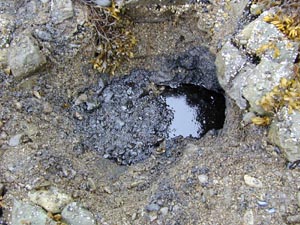If you dig into some beaches in Prince William Sound, a pool of oil will form in the hole.

NOAA Fisheries Image.
At the time of the disaster, no-one knew how far-reaching the biological effects would be or how long the oil would stay in the environment. Now, we are finding out, which gives scientists new perspectives on the most pervasive source of oil pollution: stormwater.
In a post in Wired Science, Brandon Keim writes:
"According to the National Marine Fisheries Service, six Exxon Valdez spills' worth of oil seep into the U.S. environment every single year, dripping from vehicles and washed into sewers where it's carried directly into streams and finally to the sea." Research into the Exxon Valdez could end up providing insight into what we have done, drop, by drop, to every waterway near human habitation, Keim writes.
"Unlike Prince William Sound, researchers haven't spent decades looking for damage caused by chronic oil exposures in America's waters. It's not inconceivable that a state of permanent toxicity has come to seem natural."
No comments:
Post a Comment